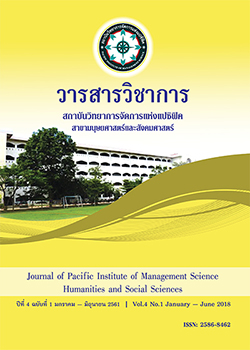A Causual Model of Infuence on Strategic Human Resounce Management for Thai’s SME’s
Keywords:
Strategic Human ResourceManagement, Market Orientation, HRM Competency, HRM Importance, CEO Characteristics, Business PerformanceAbstract
The objective of this study were on 1) to study the factor of affecting the model of strategic human resource management for small and medium enterprises in Thailand 2) to modified the empirical information 3) to study the effect of direct and indirect on the causal model and 4) to develop model of strategic human resource management in Thailand. This research was used mixed methods analysis both in qualitative and quantitative methods with 520 samples. The data were analyzed by using structural equation model (SEM). The research found that market orientation, HRM competency, HRM importance and CEO characteristics have significant direct effect to strategic human resource management and have indirect effect by strategic human resource management to business performance which is a statistically significant influence on the level of .01.
References
Andrew A. Schmidt, Kari Strobel, and Brian Dickson. (2015). Global environment, corporatestrategy, cearning culture and human capital: a theoretical review.International Journal of Organizational Innovation, 8(4): 188-200.
C-S. Lee, C-W. Chao and H-I Chen. (2015). The relationship between HRM practices and the serviceperformance of student interns: Industry perspective. S.Afr.J.Bus.Manage,46(3):1-9
Deng, S., & Dart, J. (1999). The market orientation of Chinese enterprises during a time of transition.European Journal of Marketing, 33(5/6): 631-654.
Devanna, M. A., Fombrun, C., & Tichy, N. (1981). Fluman resources management: A strategicperspective. Organizational Dynamics, 9 (3): 51-67.
Devanna, M. A., Fombrun, C., Tichy, N., & Warren, L. (1982). Strategic planning and human resourcemanagement. Human Resource Management, 21 (1): 11-18.
Guest, D. 1987. Human resource management and industrial relations. Journal of Management Studies, 24 (5): 503-521.
Guest, D. (1989). Personnel and HRM: Can you tell the difference? Personnel Management, 21: 48-51.
Guest, D. (1991). Human resource management: Its implications for industrial relations and trade unions. In J. Storey (Eds.), New perspectives on human resource management: 41-55.London: Routledge.
Guest, D. E. (1997). Human resource management and performance: A review and research agenda.International Journal of Human Resource Management, 8 (3): 263-276.
Gunnigle, P., Turner, T., & Morley, M. (1998). Strategic integration and employee relations:The impact of managerial styles. Employee Relations, 20 (2): 115
Hambrick, D. C., & Brandon, D. L. (1988). Executive values. In D. C. Hambrick (Eds.), The executive effect: Concepts and methods for studying top managers:3-34. Greenwich, CT: JAI Press.
Hambrick, D. C., & Fukutomi, G. (1991). The seasons of a CEO’s tenure. Academy of Management Review, 16 (4): 719-742.
Hambrick, D. C., & Mason, P. A. (1984). Upper echelons: The organization as a reflection of its top managers. Academy of Management Review, 9 (2): 193-206.
Hambrick, D. C., Geletkanycz, M. A., & Fredrickson, J. M. (1993). Top executive commitment to the status quo: Some tests of its determinants. Strategic Management Journal, 14 (5): 401-418.
Huselid, M. A. (1993). The impact of environmental volatility on human resource planning and strategic human resource management. Human Resource Planning,16 (3): 35-51.
Huselid, M. A. (1995). The impact of human resource management practices on turnover, productivityand corporate financial performance. Academy of Management Journal, 38 (3): 635-672.
Huselid, M. A., & Becker, B. E. (1996). Methodological issues in cross-sectional and panel estimatesof the human resource-firm performance link. Industrial Relations, 35 (1): 400-422.
Huselid, M. A., Jackson, S. E., & Schuler, R. S. (1997). Technical and strategic human resourcemanagement effectiveness as determinants of firm performance. Academy of Management Journal, 40 (1): 171-188.
Li-Qun Wei, Dequin Chen, Michael N. Young and Xinran Wang. (2014). Which CEOs are more likely to be fired in china? demographic characteristics as an antecedent. SAM AdvancedManagement Journal,79 (30):37-50.
Mitsuhashi, H., Park, H. J., Wright, P. M., & Chua, R. S. (2000). Line and HR executives’ perceptionsof HR effectiveness in firms in the People’s Republic of China. International Journal of Human Resource Management, 11 (2): 197-216.
Narver, J. C., & Slater, S. F. (1990). The effect of a market orientation on business profitability. Journal of Marketing. 54 (Oct.): 20-35.
Peggy D. Brewer, Kristen L. Brewer. (2010). Knowledge management, human resource management,and higher education: a theoretical model .Journal of Education for Business, 85(6): 330–335.
Sany Sanuri Mohd Mokhtar, Rushami Zien Yusoff and Azanin Ahmad. (2014). Key elements of market orientation on malaysian smes performance. International Journal of Business and Society, 15(1): 49 – 64.
Schendel, D. E., & Patton, G. R. (1978). A simultaneous equation model of corporate strategy.Management Science, 24: 1611-1621.
Snell, S. A. (1992). Control theory in strategic human resource management: The mediating effectof administrative information. Academy of Management Journal, 35 (2): 292-327.
Suzy Fox, Renee L. Cowan. (2015). Revision of the workplace bullying checklist: the importance of human resource management’s role in defining and addressing workplace bullying. HumanResource Management Journal,25(1): 116-130.
U-on Vichit. (2011). Global strategic planning for international business company. Journal of GlobalBusiness Review. v2n2, 45-52
U-on Vichit. (2011). How to prepare the strategic planning for organization? Journal of Global BusinessReview. v1n1, 61-66
Venkatraman, N. (1989). The concept of fit in strategy research: Toward verbal and statisticalcorrespondence. Academy of Management Review, 14 (3): 423-444.
Venkatraman, N., & Ramanujam, Y. (1986). Measurement of business performance in strategyresearch: A comparison of approaches. Academy of Management Review, 11 (4): 801-814.
Vurain Tabvuma, Yannis Georgellis And Thomas Lange. (2015). Orientation training and job satisfaction: a sector and gender analysis. Human Resource Management, 54(2):303–321.
W Wright et al. (2003). Managing the institutional environment: Challenges for foreign firms in post WTO China. S.AM. Advanced Management Journal, 68 (2): 41-49.
Yang Chen , Guiyao Tang , Jiafei Jin ,Ji Li and Pascal Paille ́. (2015). Linking market orientationand environmental performance: the influence of environmental strategy, employee’senvironmental involvement, and environmental product quality. Journal of Business Ethics,127 (2):479–500.
Zhao, S. M. (1994). Human resource management in China. Asia Pacific Journal of Human Resources, 32 (2): 3-12.
Downloads
Published
Issue
Section
License
บทความที่ได้รับการตีพิมพ์เป็นลิขสิทธิ์ของ สถาบันวิทยาการจัดการแห่งแปซิฟิค
ข้อความที่ปรากฏในบทความแต่ละเรื่องในวารสารวิชาการเล่มนี้เป็นความคิดเห็นส่วนตัวของผู้เขียนแต่ละท่านไม่เกี่ยวข้องกับสถาบันวิทยาการจัดการแห่งแปซิฟิค และคณาจารย์ท่านอื่นๆในสถาบันฯ แต่อย่างใด ความรับผิดชอบองค์ประกอบทั้งหมดของบทความแต่ละเรื่องเป็นของผู้เขียนแต่ละท่าน หากมีความผิดพลาดใดๆ ผู้เขียนแต่ละท่านจะรับผิดชอบบทความของตนเองแต่ผู้เดียว







